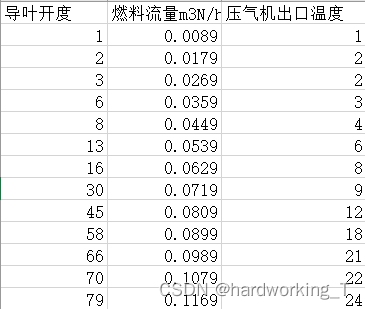文章目录
LSTM时间序列预测数据获取与预处理模型构建训练与测试
LSTM时间序列预测
对于LSTM神经网络的概念想必大家也是熟练掌握了,所以本文章不涉及对LSTM概念的解读,仅解释如何使用pytorch使用LSTM进行时间序列预测,复原使用代码实现的全流程。
数据获取与预处理
首先预览一下本次实验使用的数据集,该数据集共有三个特征,将最后一列的压气机出口温度作为标签预测(该数据集是我在git上收集到的)
定义一个xls文件读取的函数,其中data.iloc()函数是将dataframe中的数据进行切片,返回数据和标签
# 文件读取def get_Data(data_path): data=pd.read_excel(data_path) data=data.iloc[:,:3] # 以三个特征作为数据 label=data.iloc[:,2:] # 取最后一个特征作为标签 print(data.head()) print(label.head()) return data,label使用sklearn中的preprocessing模块中的归一化函数对数据进行归一化处理,其中data=data.values函数是将dataframe中的数据从pd格式转换np数组,删除轴标签,fit_transform函数是fit()和transform()的组合,是将fit和transform合并,一步到位的结果,最后返回data,label和归一化的标签值
# 数据预处理def normalization(data,label): mm_x=MinMaxScaler() # 导入sklearn的预处理容器 mm_y=MinMaxScaler() data=data.values # 将pd的系列格式转换为np的数组格式 label=label.values data=mm_x.fit_transform(data) # 对数据和标签进行归一化等处理 label=mm_y.fit_transform(label) return data,label,mm_y我们将数据进行归一化之后,数据是np数组格式,我们需要将其转换成向量的格式存储在列表当中,因此,先创建两个空列表,建立一个for循环将预处理过的数据最后按x.size(0),seq_length,features)的纬度输出至列表当中。其中seq_length代表的是时间步长,x.size(0)则表示的是数据的第一维度,features代表的是数据的特征数。打印x,y的维度并返回x,y。
# 时间向量转换def split_windows(data,seq_length): x=[] y=[] for i in range(len(data)-seq_length-1): # range的范围需要减去时间步长和1 _x=data[i:(i+seq_length),:] _y=data[i+seq_length,-1] x.append(_x) y.append(_y) x,y=np.array(x),np.array(y) print('x.shape,y.shape=\n',x.shape,y.shape) return x,y将数据和标签都准备好之后即可分离数据,将数据分离成训练集和测试集。定义split_data()函数,其中split_ratio是设定的测试集比例,本次实验设置的训练集与测试集之比为9:1,即split_ratio=0.1。将分离好的数据分别装入Variable中封装好,并且将array转换成tensor格式,得到测试集和训练集。注意,一定要使用Variable函数对数据集进行封装,否则不支持后面torch的迭代。
# 数据分离def split_data(x,y,split_ratio): train_size=int(len(y)*split_ratio) test_size=len(y)-train_size x_data=Variable(torch.Tensor(np.array(x))) y_data=Variable(torch.Tensor(np.array(y))) x_train=Variable(torch.Tensor(np.array(x[0:train_size]))) y_train=Variable(torch.Tensor(np.array(y[0:train_size]))) y_test=Variable(torch.Tensor(np.array(y[train_size:len(y)]))) x_test=Variable(torch.Tensor(np.array(x[train_size:len(x)]))) print('x_data.shape,y_data.shape,x_train.shape,y_train.shape,x_test.shape,y_test.shape:\n{}{}{}{}{}{}' .format(x_data.shape,y_data.shape,x_train.shape,y_train.shape,x_test.shape,y_test.shape)) return x_data,y_data,x_train,y_train,x_test,y_test将封装好的训练集和测试集装入torch支持的可迭代对象torch.utils.data.DataLoader中,num_epochs是计算得到的迭代次数,返回train_loader,test_loader,num_epochs,这样,数据集就预处理好了,可以进行模型的搭建了。
# 数据装入def data_generator(x_train,y_train,x_test,y_test,n_iters,batch_size): num_epochs=n_iters/(len(x_train)/batch_size) # n_iters代表一次迭代 num_epochs=int(num_epochs) train_dataset=Data.TensorDataset(x_train,y_train) test_dataset=Data.TensorDataset(x_train,y_train) train_loader=torch.utils.data.DataLoader(dataset=train_dataset,batch_size=batch_size,shuffle=False,drop_last=True) # 加载数据集,使数据集可迭代 test_loader=torch.utils.data.DataLoader(dataset=test_dataset,batch_size=batch_size,shuffle=False,drop_last=True) return train_loader,test_loader,num_epochs模型构建
使用torch构建模型无非就是定义一个类,在这个类中定义一个模型实例和前向传播函数,就这么简单,接下来让我们来看看。
# 定义一个类class Net(nn.Module): def __init__(self,input_size,hidden_size,num_layers,output_size,batch_size,seq_length) -> None: super(Net,self).__init__() self.input_size=input_size self.hidden_size=hidden_size self.num_layers=num_layers self.output_size=output_size self.batch_size=batch_size self.seq_length=seq_length self.num_directions=1 # 单向LSTM self.lstm=nn.LSTM(input_size=input_size,hidden_size=hidden_size,num_layers=num_layers,batch_first=True) # LSTM层 self.fc=nn.Linear(hidden_size,output_size) # 全连接层 def forward(self,x): # e.g. x(10,3,100) 三个句子,十个单词,一百维的向量,nn.LSTM(input_size=100,hidden_size=20,num_layers=4) # out.shape=(10,3,20) h/c.shape=(4,b,20) batch_size, seq_len = x.size()[0], x.size()[1] # x.shape=(604,3,3) h_0 = torch.randn(self.num_directions * self.num_layers, x.size(0), self.hidden_size) c_0 = torch.randn(self.num_directions * self.num_layers, x.size(0), self.hidden_size) # output(batch_size, seq_len, num_directions * hidden_size) output, _ = self.lstm(x, (h_0, c_0)) # output(5, 30, 64) pred = self.fc(output) # (5, 30, 1) pred = pred[:, -1, :] # (5, 1) return pred首先定义一个实例,其中包括必须参数input_size,hidden_size,num_layers,output_size,batch_size,seq_length。将self.num_directions设置为1代表这是一个单项的LSTM,然后再添加一个lstm层和一个全连接层fc,lstm层输入维度为(input_size=input_size,hidden_size=hidden_size,num_layers=num_layers),设置了,batch_first=True则代表shape=(batch_size,seq_size,hidden_size),fc层的参数为(hidden_size,output_size),返回pred
训练与测试
训练模型,初始化i,(batch_x, batch_y),将train_loader设置为枚举类型,optimizer.zero_grad() 代表将每次传播时的梯度累积清除,torch中如果不声明optimizer.zero_grad()则会一直累积计算梯度,设置每100次输入打印一次损失
# trainiter=0for epochs in range(num_epochs): for i,(batch_x, batch_y) in enumerate (train_loader): outputs = moudle(batch_x) optimizer.zero_grad() # 将每次传播时的梯度累积清除 # print(outputs.shape, batch_y.shape) loss = criterion(outputs,batch_y) # 计算损失 loss.backward() # 反向传播 optimizer.step() iter+=1 if iter % 100 == 0: print("iter: %d, loss: %1.5f" % (iter, loss.item()))最后几次损失如下
iter: 2400, loss: 0.00331iter: 2500, loss: 0.00039...iter: 4400, loss: 0.00332iter: 4500, loss: 0.00022iter: 4600, loss: 0.00380iter: 4700, loss: 0.00032将最后训练集和测试集的MAE/RMSE画出,得到最终结果。
def result(x_data, y_data): moudle.eval() train_predict = moudle(x_data) data_predict = train_predict.data.numpy() y_data_plot = y_data.data.numpy() y_data_plot = np.reshape(y_data_plot, (-1,1)) data_predict = mm_y.inverse_transform(data_predict) y_data_plot = mm_y.inverse_transform(y_data_plot) plt.plot(y_data_plot) plt.plot(data_predict) plt.legend(('real', 'predict'),fontsize='15') plt.show() print('MAE/RMSE') print(mean_absolute_error(y_data_plot, data_predict)) print(np.sqrt(mean_squared_error(y_data_plot, data_predict) ))result(x_data, y_data)result(x_test,y_test)

最终结果:训练集:MAE/RMSE:35.114613\75.8706
测试集:MAE/RMSE:213.30313\213.31061
本文仅作示范pytorch构建lstm的用法,预测结果不是很准确,像dropout等都没加,仅供参考。
完整代码见我的github:https://github.com/Tuniverj/Pytorch-lstm-forecast